Column graph
A column graph is a graph used in statistics for organising and displaying categorical data.
To construct a column graph, equal width rectangular bars are constructed for each category with height equal to the observed frequency of the category as shown in the example below which displays the hair colours of 27 students.
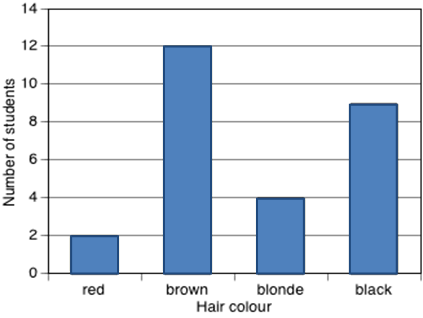
Column graphs are frequently called bar graphs or bar charts. In a bar graph or chart, the bars can be either vertical or horizontal, but are never joined (there is always a gap left between them). See also: categorical data.
Common factor
A common factor (or common divisor) of a set of numbers or algebraic expressions is a factor of each element of that set. For example,![]() is a common factor of {24, 54, 66} as 6 divides evenly into each of these numbers, and 3 is a common factor of
is a common factor of {24, 54, 66} as 6 divides evenly into each of these numbers, and 3 is a common factor of ![]() for the same reason.
for the same reason.
Note that ![]() is a common factor of
is a common factor of ![]() because
because
![]()
![]() and
and ![]()
See also: algebraic expression.
Commutative
An operation is commutative if the result of applying the operation to any two elements of a set is the same, regardless of the order of the elements. Addition and multiplication are commutative on the set of natural numbers, for example:
6 + 12 = 12 + 6 = 18 and 6 × 12 = 12 × 6 = 72
However, subtraction and division are not commutative for example:
6 − 12 = − 6 but 12 − 6 = 6 and 6 ÷ 12 = ![]() but 12 ÷ 6 = 2.
but 12 ÷ 6 = 2.
See also: commutative laws.
Commutative Laws
In general, the commutativelaws (properties) for addition and multiplication of real numbers state that for all real numbers ![]() and
and ![]() ,
, ![]() and
and ![]() , respectively. See also: commutative.
, respectively. See also: commutative.
Complement (set)
The set of all elements not in a given set with respect to the universal set for a particular context or situation is the complement set.
For example, if the universal set in a particular situation is taken to be the letters of the alphabet, the complement to the set of vowels is the rest of the alphabet. If the universal set in a particular situation is taken to be the set of numbers {1, 2, 3, 4, 5, 6, 7, 8, 9, 10}, then the complement to ![]() = {4, 5, 6} is the set {1, 2, 3, 7, 8, 9, 10}. The complement of
= {4, 5, 6} is the set {1, 2, 3, 7, 8, 9, 10}. The complement of ![]() is written as
is written as ![]() , or
, or ![]() . So here we could write
. So here we could write![]() {1, 2, 3, 7, 8, 9, 10}. See also: element, set.
{1, 2, 3, 7, 8, 9, 10}. See also: element, set.
Complementary angles
Two adjacent angles that form a right angle are said to be complementary angles, that is the sum of the angle measures in degrees of complementary angles is 90°. An example of two complementary angles is shown below:
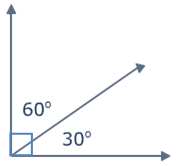
See also: adjacent, angle.
Complementary events
Events ![]() and
and ![]() are complementary events, if
are complementary events, if ![]() and
and ![]() are mutually exclusive and
are mutually exclusive and
![]() where
where ![]() is the probability of event
is the probability of event ![]() and
and ![]() the probability of event
the probability of event ![]() . For example,
. For example, ![]() and
and ![]() are complementary events if
are complementary events if ![]() is the probability of rolling a 3 on a dice and
is the probability of rolling a 3 on a dice and ![]() the probability of not rolling a 3. This is because
the probability of not rolling a 3. This is because
![]() .
.
Composite number
A non-zero natural number that has a factor other than 1 and itself is a composite number. Using sets, a non-zero natural number which has more than two distinct elements in its factor set is a composite number.
For example, 8 is a composite number as it has four distinct elements in its factor set: {1, 2, 4, 8}. The number 2 is not a composite number since it has only two distinct elements in its factor set: {1, 2}. With the exception of 1, which has only one distinct element in its factor set: {1}, all non-zero natural numbers are either composite or prime. See also: factor, natural number, prime number.
Compound interest
The interest earned by investing a sum of money (the principal) is compound interest if each successive interest payment is added to the principal for the purpose of calculating the next interest payment. If the principal ![]() earns compound interest at the rate of
earns compound interest at the rate of ![]() per period, then after
per period, then after ![]() periods the principal plus interest is
periods the principal plus interest is ![]() .
.
For example, if $2000 is deposited into a savings account (![]() ) at an annual interest rate of 2% (
) at an annual interest rate of 2% (![]() ), compounded monthly (period is months), the value of the investment after 5 years (
), compounded monthly (period is months), the value of the investment after 5 years (![]() months
months ![]() ) would be
) would be ![]() .
.
See also: simple interest.
Computation
Computation is the action of a mathematical calculation. Computation may also be used in the context of computer science.
Computational thinking
In this context, computational thinking is considered to be linked to algorithmic thinking. This type of thinking is usually considered specific to computers which involves solving problems, designing systems and implementation. See also: algorithmic thinking, implementation.
Concave (shape)
See polygon.
Cone
A cone is a solid that is formed by taking a circular base and a point not in the plane of this circle (either above or below the circle) called the vertex, and joining the vertex to each point on the circumference of the circular base.
A right-cone, or vertical cone, is a cone with its vertex directly above the centre of the circular base. The term “cone” is often used to mean a right-cone.
An example of a right-cone is below:
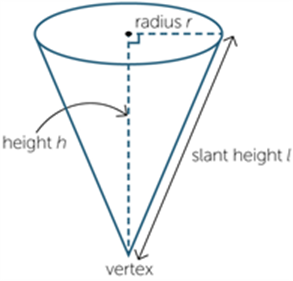
A slant cone is a cone with a vertex not directly above the centre of the circular base, as shown below:
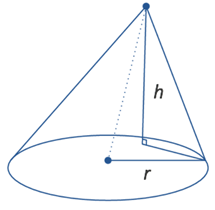
A cone may be said to be open or closed depending on whether the circular end is included. For example, an ice-cream cone would be an example of an open cone.
If a closed cone has radius r units, and height ![]() units, then its surface area,
units, then its surface area, ![]() units2 is given by
units2 is given by ![]() , and its volume
, and its volume ![]() units3 is given by
units3 is given by ![]()
For example, if a cone has a radius of 3 cm and a height of 4 cm then the surface area ![]() , and its volume
, and its volume ![]() units3 would be
units3 would be ![]()
Conditional Statement
A conditional statement is part of an algorithm which will engage different processes depending on a specific state of inputs at that point, and is of the form “if a then b” for a condition a and a process b.
For example, in a function machine which outputs only even numbers, if the input number ![]() is odd, then the output could be
is odd, then the output could be ![]() . If the input number is even, then the output could be
. If the input number is even, then the output could be ![]() . All input numbers will then result in an even number being output.
. All input numbers will then result in an even number being output.
Congruence
Two plane figures are called congruent if one can be moved by a sequence of translations, rotations and reflections so that it fits exactly on top of the other figure.
Two figures are congruent when we can match every part of one figure with the corresponding part of the other figure. For example, the two figures below are congruent.
Matching intervals have the same length, and matching angles have the same size.

See also: rotation, reflection, transformation.
Congruent triangles
The following are sets of conditions for a pair of triangles to be congruent:
See also: congruent, transformation.
Conjecture
A conjecture is statement whose truth or otherwise is not yet determined but is open to further investigation. For example, Goldbach's Conjecture: “every even natural number greater than 2 can be expressed as a sum of two prime numbers”. First stated in 1742, the Goldbach conjecture has not yet been either proven to be true or shown to be false, although many mathematicians believe that it is true.
Connected
Two points in the plane are said to be connected if there is a line or curve (edge) that joins them. A set of points in the plane, such as a network, is said to be connected if there are no two points in the set which are not connected, that is, every point can be reached from another point. A set of points that is not connected is called disconnected.
Examples of a connected graph (network) and a disconnected graph respectively are shown below:

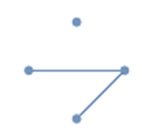
See also: network.
Connective
A logical term that connects or qualifies other expressions, such as ‘and’, ‘or’, ‘not’, ‘if ... then ...’ and ‘is equivalent to’. For example, given a set of attribute blocks, specifying the blocks that are red and square involves two attributes ‘red’, ‘square’ which apply to some blocks but not to others. The use of the connective and to specify ‘red’ and ‘square’ required both attributes to apply.
Constant
A constant is a number that has a fixed value in a given context. For example, in the calculation of ![]() for different natural numbers
for different natural numbers ![]() , the number 11 is a constant. In formulas such as
, the number 11 is a constant. In formulas such as ![]() , 4 is a constant while
, 4 is a constant while ![]() and
and ![]() are variables.
are variables.
Undetermined constants are constants without known values. For example, the general linear equation ![]() has two such constants:
has two such constants: ![]() and
and ![]() . Two or more points that lie on a line could be used to find the values of
. Two or more points that lie on a line could be used to find the values of ![]() and
and ![]() for the equation
for the equation ![]() which describes the line. See also: variables.
which describes the line. See also: variables.
Constraint
A condition which is applied in a given context is a constraint. For example, in solving the equation ![]() , a constraint may be that only natural number solutions are required (there are an infinite number of integer solutions).
, a constraint may be that only natural number solutions are required (there are an infinite number of integer solutions).
Continuous
Continuous data can, in principle, assume all possible values in a given interval. For example, height is a continuous data measurement. While the actual height of a person can only be physically measured to a given accuracy, it is possible in principle for a person’s height to be any value within a typical range of heights for a human being.
See also: numerical variable, variable.
Continuous variable
A continuous variable is a variable that can take any value over an interval subset of the real numbers. Examples of continuous variables for measurement data are height, reaction time to a stimulus and systolic blood pressure. See also: numerical variable, variable.
Convex (shape)
See polygon.
Coordinate
The position of any point on a plane can be represented by an ordered pair of numbers, given a specified set of axes. For example, the ordered pair (![]() ) in the Cartesian plane (where the two axes are labelled
) in the Cartesian plane (where the two axes are labelled ![]() and
and ![]() )is found at the point where both
)is found at the point where both ![]() and
and
![]() . This ordered pair is called the coordinates of the point. The
. This ordered pair is called the coordinates of the point. The ![]() coordinate (or abscisse) is the first number
coordinate (or abscisse) is the first number ![]() in this ordered pair, the
in this ordered pair, the ![]() coordinate (or ordinate) the second number,
coordinate (or ordinate) the second number, ![]() .
.
Coordinate system
There exist many coordinate systems, depending on the coordinate axes chosen. An example of a coordinate system is the Cartesian coordinate system.
See: Cartesian coordinate system
Co-prime
Two positive integers which have no common factors other than 1 are said to be co-prime. For example, 27 and 32 are co-prime because their factor sets are {1, 3, 9, 27} and
{1, 2, 4, 8, 16, 32} respectively, with the only common factor being 1. See also: factors.
Correspondence
Four classes of correspondence may be considered:
See also: function, range, relation.
Corresponding angles
Angles which are adjacent to a transversal intersecting a pair of lines, as indicated in the diagram are said to be corresponding angles. Corresponding angles are on the same side of the traversal and both above or both below the line the transversal intersects:
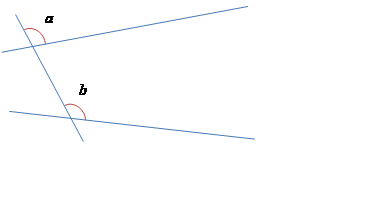
If the pair of lines are parallel, then corresponding angles have equal measure.
Conversely, if a pair of corresponding angles have equal measure then the two lines the transversal intersects are parallel.
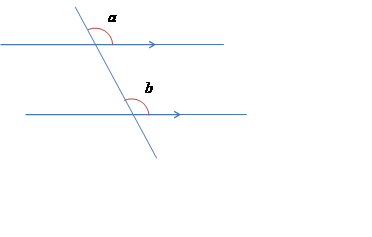
See also: angle, parallel, transversal.
Cosine
In any right-angled triangle, ![]() where
where ![]()
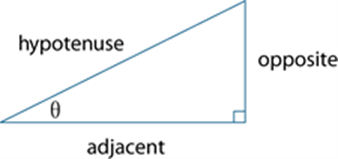
See also: trigonometry.
Cosine rule
In any triangle ABC as below, the cosine rule is given by: ![]()
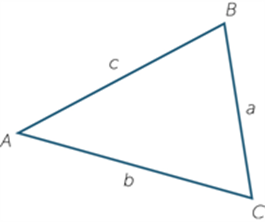
Counter-example
A counter-example is an instance where a proposition or conjecture is false. For example, the number 6 is a counter-example to the proposition that every even number is also a multiple of four.
Source: https://victoriancurriculum.vcaa.vic.edu.au/LearningArea/LoadFile?learningArea=mathematics&subject=mathematics&name=Mathematics%20Glossary.docx&storage=Glossary
Web site to visit:ttps://victoriancurriculum.vcaa.vic.edu.au
Author of the text: indicated on the source document of the above text
If you are the author of the text above and you not agree to share your knowledge for teaching, research, scholarship (for fair use as indicated in the United States copyrigh low) please send us an e-mail and we will remove your text quickly. Fair use is a limitation and exception to the exclusive right granted by copyright law to the author of a creative work. In United States copyright law, fair use is a doctrine that permits limited use of copyrighted material without acquiring permission from the rights holders. Examples of fair use include commentary, search engines, criticism, news reporting, research, teaching, library archiving and scholarship. It provides for the legal, unlicensed citation or incorporation of copyrighted material in another author's work under a four-factor balancing test. (source: http://en.wikipedia.org/wiki/Fair_use)
The information of medicine and health contained in the site are of a general nature and purpose which is purely informative and for this reason may not replace in any case, the council of a doctor or a qualified entity legally to the profession.
The texts are the property of their respective authors and we thank them for giving us the opportunity to share for free to students, teachers and users of the Web their texts will used only for illustrative educational and scientific purposes only.
All the information in our site are given for nonprofit educational purposes